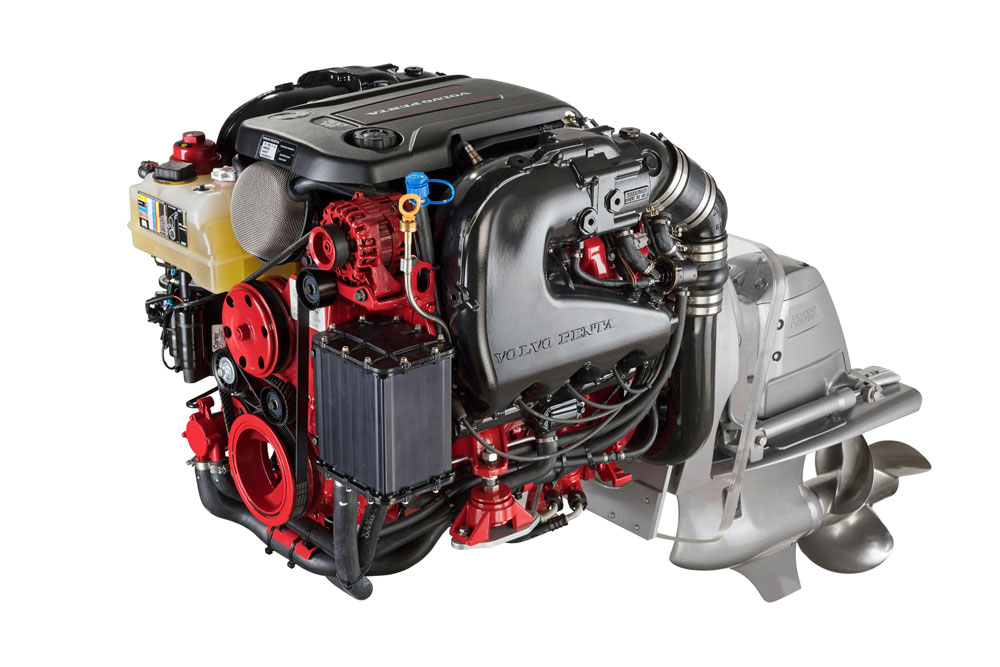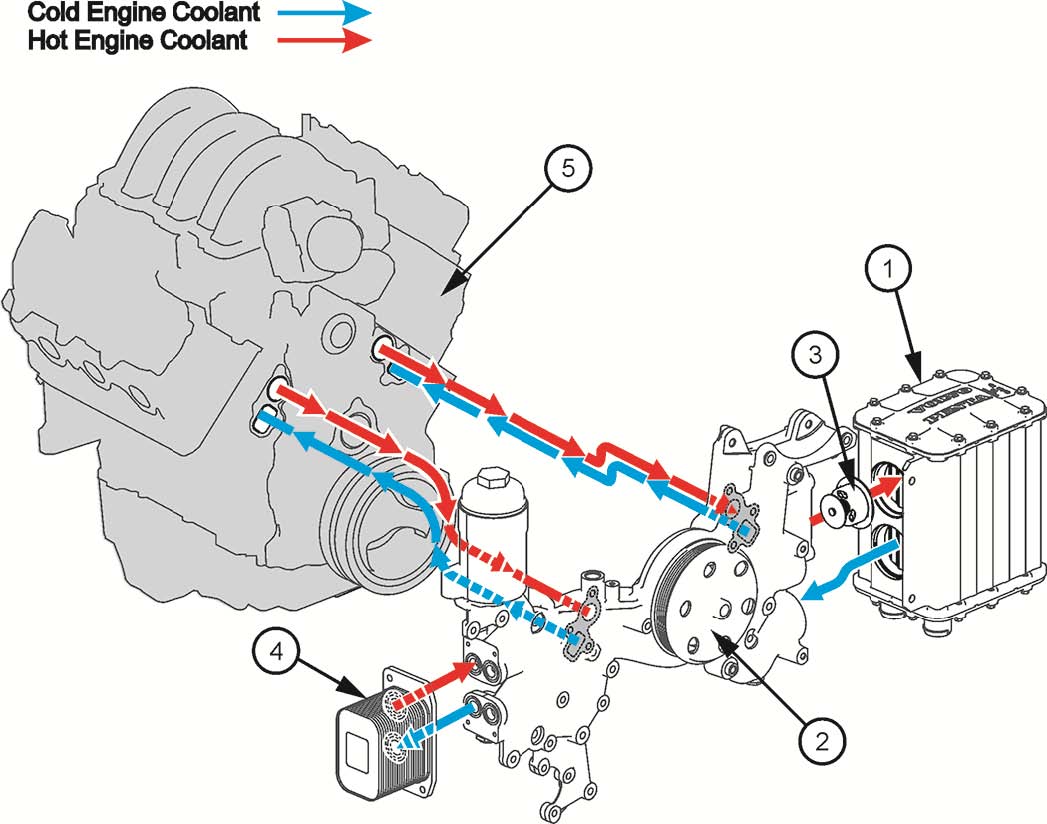Volvo Penta Introduces Next Generation V8 and V6 Gasoline Engines
Loaded with current automotive engine design features, this new series of gasoline sterndrive engines promises to be sophisticated, powerful, and thrifty.
If you like bells and whistles, the new generation Volvo Penta gasoline marine engines will be appealing. The just-announced 5.3-liter V8 and a 4.3-liter V6 revealed earlier this year will form the core of the future Volvo Penta sterndrive engine range. Both engines are based on the General Motors Gen V engine series, and are packed with features GM has developed for automobile applications, including an aluminum block, direct fuel injection, variable valve timing, and an emissions system utilizing the latest wide-band oxygen sensors. Volvo Penta says these engines will deliver stronger acceleration and better fuel economy than the engines they replace, while also being significantly lighter in weight. The 5.3-liter V8 will be offered with a 300 horsepower or 350 horsepower rating. The 4.3-liter V6 is rated at 200, 240 or 280 horsepower.

Regular service points on the Volvo Penta V8-300/350 have been positioned on the front of the engine, including the white coolant expansion tank and coolant fill, power steering dipstick, oil filter, fuel filter and flush fitting. The black cube on the port side of the engine is the heat exchanger.
It’s fascinating that the embrace by Volvo Penta of these GM engines and their associated technical features represent the exact opposite philosophy espoused by Mercury Marine, the chief rival to Volvo Penta in the gas engine market. In fact, Mercury explicitly claims these very features–direct injection, aluminum block, variable valve timing, mandatory closed cooling–add no value to a marine engine, and are the reason that, rather than buy and marinize the GM engines, Mercury designed its own MerCruiser 4.5-liter V6 and 6.2-liter V8 engines.
Ron Huibers, president of Volvo Penta of the Americas, explained the Volvo Penta perspective at the formal introduction of the new Volvo Penta engines.
“Volvo Penta was the first to introduce automotive-based gas and diesel sterndrive engines into the marine industry to give improved technology, performance, reliability and competitive cost,” said Huibers. “That strategy going back over 100 years has an undisputed proven track record. Simply, it enables us to offer the boating industry technology that would otherwise be cost-prohibitive. As new-technology automotive engines continue to increase the power density, customers can get increased performance for less cost. With over 1.3 million Gen V engines in operation, customers are getting proven quality, reliability and long life. This gives unprecedented economy of scale and enables us to introduce new technologies that have never before been available in the marine industry at an affordable price.”
Clearly there’s more than one way to skin this cat, and I’m certain there are many underlying reasons each company chose its path forward. But they may both lead to the same destination: satisfying performance.
The Bells and Whistles
The Volvo Penta V8-300C and V8-350C/CE (300 and 350 horsepower respectively) and the V6-200/240/280C/CE share the following features. The CE version of each engine is equipped with Electronic Vessel Control, including digital throttle/shift, digital instrumentation with an e-key switch, and EVC monitoring panels. These engines also share most service parts, and each is backed by a five-year warranty in North America.
Direct Fuel Injection
A fuel injector is located in the cylinder head and squirts fuel directly into each combustion chamber at 2,250 psi. This high pressure creates very small fuel droplets, which ignite quickly and burn efficiently. The system operates at a lower temperature than conventional port injection, so the air charge stays cooler and denser. Direct-injection also allows the mixture to be leaner, so less fuel is required to produce the equivalent horsepower of a conventional port-injection fuel system. Fuel delivery can be very precisely controlled to improve economy and reduce emissions, because less fuel escapes out the open exhaust valve. Direct-injection also permits a rather high 11:1 compression ratio, which improves torque output, key to marine performance. Despite this high compression ratio, all of these new engines can operate on 87 octane gasoline. Direct fuel injection has been a feature of low-emissions two-stroke outboards for some time and is the technology behind Evinrude’s newest E-TEC G2 outboard engines.
All-Aluminum Block
Volvo Penta says the 5.3-liter engine alone weighs 744 pounds, or about 119 pounds less than its previous-generation engine with a cast-iron block and heads. The new MerCruiser 6.2-liter V8, which has an iron block and heads but open cooling, weighs 862 pounds. Less weight improves efficiency both on the water and when the boat is being towed on the highway.
Standard Closed Cooling
A closed-cooling system is standard on all of the new Volvo Penta V8 and V6 engines. Coolant (antifreeze) circulates through the engine and to a heat exchanger mounted on the front of the engine, where raw water cools it. The system also incorporates an oil cooler. This obviously keeps raw water (especially salt water) away from those alloy engine components, but because these engines have very tight tolerances they require a precise and consistent coolant temperature. Raw water, of course, can vary wildly in temperature.

Volvo Penta designed a cooling system that mounts on the front of the new 5.7-liter V8 engine, supported by a central cast manifold. Components include 1) Heat Exchanger 2) Raw Water Pump 3) Thermostat 4) Oil Cooler 5) Engine Block.
Modern engines also rely on a very high volume of coolant flow to maintain consistent internal temperature, and have a high-volume coolant pump. This adds some expense compared to an engine with open cooling, but it’s part of the price to be paid for this new engine. The heat exchanger and raw water pump will still need to be drained for winter lay-up.
Variable Valve Timing
These engines use pushrod valve actuation (rather than overhead cams). To achieve variable valve timing (VVT), the phase of the entire cam is electro-hydraulically adjusted to advance or retard the cam timing on intake and exhaust lobes. The goal is to achieve near-linear delivery of peak torque over a broader RPM range. Some four-stroke outboard motors have a more-complex VVT in conjunction with double overhead cams that time the intake and exhaust independently. The premise is the same–instead of accepting a “compromise” cam timing that might work best at high or low engine speeds, the cam timing can be adjusted through a range that enhances both bottom-end and top-end performance. This produces a stronger hole-shot and improved top speed. Combined with the high compression ratio, the engine can be tuned to deliver stout torque across its range, just what a big, heavy boat needs.
Here’s feedback on the 5.3-liter V8 from Christophe Levigne, Vice President of Engineering at Rec Boat Holdings: “The most impressive improvement is coming from the mid-range acceleration,” said Lavigne. “It literately throws you back in the seat. Having that additional rush of power, while the boat is already on plane at fair speed, makes the driving experience more thrilling.” Zoom zoom, indeed.
Wide Band Oxygen Sensors
Volvo Penta says these sensors, which measure the amount of oxygen in the exhaust and send that data to the engine control system, work across a broader range of elevations, fuel quality, and weather conditions, and help reduce carbon monoxide emissions by 95-percent. Claimed combined emissions are at the very bottom of the EPA standard for marine sterndrive engines.
A boat owner may not notice ultra-low exhaust emissions, but an eight percent improvement in fuel economy is hard to miss. That’s the gain Volvo Penta is claiming for the two 5.3-liter V8 variants at best cruising speed, compared to its previous 300 and 350 horsepower models. The gain in top speed is negligible, but zero to 30 MPH performance is improved by up to 22 percent (for the V8-300C) compared to the previous engine. The 4.3-liter V6 engines offer eight to 10 percent better cruise economy, according to Volvo Penta, and zero to 30 MPH acceleration that’s 15 to 31 percent quicker than the engines they replace.
Each of the 5.3-liter V8 and 4.3-liter V6 engines will be offered with the entire matrix of Volvo Penta sterndrive options, including the Aquamatic SX, Duoprop and the all new Forward Drive. An exception is the V8-350C/CE, which is not available with the single-prop SX outdrive.
It’s hard to pinpoint the cost of all this technology, because most sterndrive powertrains are sold directly to boat builders, who each negotiate pricing with the engine supplier and then can set their own pricing for engine choices. I have spoken to a couple of leading independent boat builders, who say that their pricing for the new-generation Volvo Penta engines and the comparable new engines from MerCruiser is very similar.
For more information, visit Volvo Penta.












